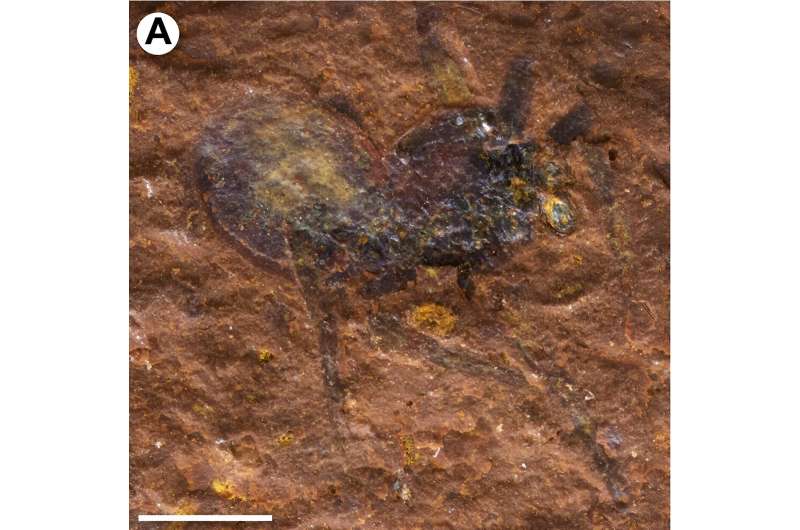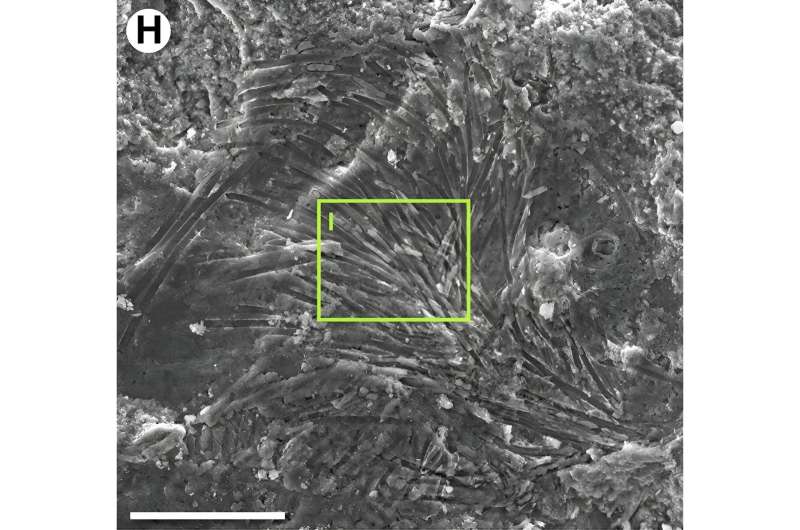This article has been reviewed according to Science X's editorial process and policies. Editors have highlighted the following attributes while ensuring the content's credibility:
fact-checked
peer-reviewed publication
trusted source
proofread
A fossil jumping spider's 15-million-year journey

Jumping spiders (Salticidae) are a recently evolved family of spiders. They are known for their distinctive large eyes and ability to jump long distances relative to their small size. Australia has about 1,200 to 1,500 species of this spider family. Only 500 have scientific names.
Fossil jumping spiders are rare. The majority that have been found are preserved in Baltic or Mexican amber. Fossil jumping spiders from Australia could tell us more about the evolutionary history of this group. However, until recently none had been discovered.
Jumping into spider research
Dr. Barry Richardson is an honorary fellow who researches jumping spiders at the Australian National Insect Collection. One, day, he found himself working beside Associate Professor Michael Frese from the University of Canberra at the insect collection's photomicroscopes.
"Michael noticed a jumping spider on my screen and offered to show me a tiny spider fossil he'd noticed while studying plants from a fossil bed, from near Gulgong in New South Wales," Barry said.
"I knew straight away we were looking at the first fossil jumping spider from the southern hemisphere."
They were joined by Dr. Matthew McCurry, a paleontologist at the Australian Museum. Together with Michael, Matthew leads the studies of the fossil site. Combining their very different skills led to an amazing array of insights into the natural world.
Rare fossil spins tale of ancient arachnids
The fossil bed containing the jumping spider dates from the middle of the Miocene epoch, 11 to 16 million years ago. It's a Konservat-Lagerstätte, a fossil site with extraordinarily well-preserved specimens. These specimens include microfossils, plants, insects, vertebrates and the jumping spider.
The jumping spider is visible from the dorsal (top) side and hasn't been distorted during fossilization. It is about 2.5 mm long with a short, rounded cephalothorax (head and thorax). The large lenses of its two front eyes are visible, surrounded by short setae (stiff hairs). There is one fang and most of its legs are visible, including joints and setae.
"Michael's careful study showed that not only was the hardened exoskeleton of the spider preserved, but so were some of the spider's internal structures," Barry said.
"This included what seemed to be parts of the pharyngeal plate that sieves food inside the mouth."
To check this wasn't an artifact of fossilization, Barry dissected modern jumping spider specimens held in the Australian National Insect Collection. Michael gold-plated their mouthparts and took additional electron micrographs.
"He found that the pharyngeal plates of the fossil were quite similar to those dissected from the modern specimens," Barry said.
Barry said the morphology of the spider was so well-preserved they could study the structure of its brain.
"Michael realized there was a strange set of parallel tubes that appeared to be a neuropile, a bundle of nerves connecting the eyes to the brain. Their diameter would have affected the speed of signal transmission along the nerves. Having fossils that allow us to study the evolution of brain functions is very exciting," he said.

Unspinning the secrets of jumping spiders
The team went on to combine information about:
- the fossil jumping spider's morphology (how it looks)
- a map of where similar spiders live today, created using specimens held in museums and collections
- the past climate of the fossil site, based on fossilized vegetation at the site.
They discovered the fossil spider's genus (group of species), realized that its close relatives are still alive today, and mapped where to find them.
"The fossilized jumping spider belonged to Simaetha, a genus of jumping spiders that still exists. From DNA studies, we knew the group this genus belongs to probably evolved in Australia only a few million years before the time this spider was fossilized," Barry said.
"The fossil shows that the distinctive morphology of Simaetha had evolved fairly quickly, but for the next 15 million years it didn't change! We wanted to know why.
"Using information on the climate profile of the fossil site, generated through analyses of the fossilized vegetation, Matthew mapped where such conditions occur today. We then compared this with the predicted distribution map of the Simaetha today, made using the specimens in museums around Australia.
"'Lo and behold, the two maps matched! Modern species are found in the same habitat and climatic conditions as the fossil, although it is now in eastern Queensland rather than central New South Wales.
"Not only do the fossil and modern spiders look the same, they also still live in the same type of environment."
The paper, "Description and evolutionary biogeography of the first Miocene jumping spider (Aranaea: Salticidae) from a southern continent," was published in Zoological Journal of the Linnean Society.
More information: Barry J Richardson et al, Description and evolutionary biogeography of the first Miocene jumping spider (Aranaea: Salticidae) from a southern continent, Zoological Journal of the Linnean Society (2023). DOI: 10.1093/zoolinnean/zlad105. academic.oup.com/zoolinnean/ad … nean/zlad105/7279405
Journal information: Zoological Journal of the Linnean Society
Provided by CSIRO





















